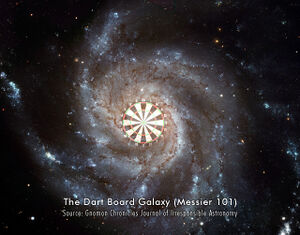Dart Board Galaxy: Difference between revisions
Jump to navigation
Jump to search
No edit summary |
No edit summary |
||
| Line 18: | Line 18: | ||
== External links == | == External links == | ||
* [ Post] @ Twitter (March 2022) | * [https://twitter.com/GnomonChronicl1/status/1507852419413204994 Post] @ Twitter (26 March 2022) | ||
* [https://en.wikipedia.org/wiki/Pinwheel_Galaxy Pinwheel Galaxy] @ Wikipedia - (also known as Messier 101, M101 or NGC 5457) - a face-on spiral galaxy 21 million light-years (6.4 megaparsecs) away from Earth in the constellation Ursa Major. It was discovered by Pierre Méchain in 1781 and was communicated that year to Charles Messier, who verified its position for inclusion in the Messier Catalogue as one of its final entries. | * [https://en.wikipedia.org/wiki/Pinwheel_Galaxy Pinwheel Galaxy] @ Wikipedia - (also known as Messier 101, M101 or NGC 5457) - a face-on spiral galaxy 21 million light-years (6.4 megaparsecs) away from Earth in the constellation Ursa Major. It was discovered by Pierre Méchain in 1781 and was communicated that year to Charles Messier, who verified its position for inclusion in the Messier Catalogue as one of its final entries. | ||
Revision as of 07:59, 29 December 2022
The Dart Board Galaxy (Messier 101a) is a face-on dartboard-type galaxy 21 million light-years (6.4 megaparsecs) away from Earth in the constellation Ursa Pseudo.
In the News
Armageddon Hard is a 1998 American planetary catastrophe heist film about a New York City detective (Bruce Willis) who must stop a rogue splinter asteroid (99942 Apophis-B) from destroying the earth.
Fiction cross-reference
Nonfiction cross-reference
External links
- Post @ Twitter (26 March 2022)
- Pinwheel Galaxy @ Wikipedia - (also known as Messier 101, M101 or NGC 5457) - a face-on spiral galaxy 21 million light-years (6.4 megaparsecs) away from Earth in the constellation Ursa Major. It was discovered by Pierre Méchain in 1781 and was communicated that year to Charles Messier, who verified its position for inclusion in the Messier Catalogue as one of its final entries.

